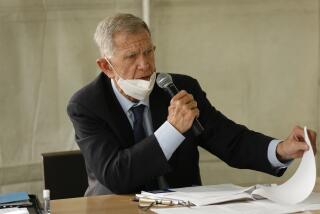Bradley, County at Odds Over Housing
- Share via
With Reagan Administration housing funds rapidly running out and the area’s homeless population growing, Los Angeles Mayor Tom Bradley in January proposed financing new low-cost housing with more than $2 billion in property tax revenues to be generated by construction in the city’s downtown redevelopment area.
But, The Times has learned, the mayor has encountered a powerful foe--Los Angeles County.
County officials are concerned that the mayor’s plan, while helping the housing shortage, would take property tax revenue away from other needs, including law enforcement, the courts, county hospitals and health clinics and welfare.
“The magnitude of your proposal in terms of revenue loss to the county would substantially impact our finances and ability to deliver essential public services,” Richard B. Dixon, county chief administrative officer, said in a letter to Bradley on Feb. 25. Dixon, in an interview Tuesday, said the county has the power to block the city plan.
Heart of the Struggle
The dispute between the two levels of government reaches to the heart of local government’s struggle over balancing priorities in spending scarce tax dollars. On one side is a coalition of high-rise-oriented downtown business leaders and those advocating more government aid in providing affordable housing in a city where residential costs are rising.
On the other side are lawmakers and other government officials pressed by residents throughout the county to provide better police and fire protection, improved schools and smooth streets to neighborhoods from Long Beach to Lancaster.
For years, the city’s Community Redevelopment Agency has helped finance new housing for low-income residents with revenue generated by the high-rise construction boom in the downtown redevelopment area.
The redevelopment agency takes over land at a comparatively low price and sells it cheaply to developers. When new buildings go up, property taxes rise, boosting government revenues. This additional tax revenue is known technically as a tax increment.
In addition to being used for new homes and apartments, tax increments have financed the extensive public works--ranging from upgrading utilities to improving streets--needed to accommodate the new high-rises. Some has gone for public amenities, such as the Los Angeles Theatre Center, designed to make downtown more attractive.
The most recent CRA budget reduced the amount of money for housing, prompting protests from advocates for the poor that the agency favored downtown high-rises at the expense of low-cost homes and apartments.
Same Dispute Elsewhere
The same sort of dispute has occurred in other urban areas, with redevelopment-minded cities feuding with levels of government also dependent on property taxes, such as counties and school districts, which also want a share.
In the case of Los Angeles, the county, along with City Councilman Ernani Bernardi, a San Fernando Valley lawmaker critical of downtown redevelopment, persuaded a court in 1977 to impose a $750-million cap on the amount of redevelopment-generated property tax revenues that could be spent by the redevelopment agency.
Anything above that would go to the county, local schools or the city’s General Fund, where it could be allocated for the Police and Fire departments, street repair and other services that could be spread around the city instead of centered downtown.
Bradley in January proposed that the amount of property tax revenue given to the redevelopment agency be raised from $750 million to $5 billion.
In his letter to Bradley, county Chief Administrative Officer Dixon said that as property tax dollars for the redevelopment agency rise, money for the county falls.
Over the next 20 years, he said, “we are currently projecting a $2.1-billion loss based on our knowledge of your proposal and there are serious ramifications associated with such revenue losses.”
It was the second critical letter Dixon had sent Bradley. Twenty-three days earlier, The Times learned, he sent a longer letter to the mayor asking for details of just how much money would be used for housing and how much for public works and more amenities for downtown.
Dixon noted that about half of the redevelopment agency’s new property tax revenue would be used for housing and other services for the homeless.
“What does the city plan to do with the remaining $2.12 billion?” Dixon asked.
That point was also raised by Councilman Bernardi. He said in an interview that he would support using additional property tax revenue for housing but would oppose spending any more on supporting downtown redevelopment.
“I don’t see any justification for more downtown development when the housing situation is going to blow us out of the water,” he said.
The court that set the $750-million limit would have to approve the Bradley plan. Dixon said he believes that the county and Bernardi, as plaintiffs in the 1977 lawsuit, would also have to approve.
Los Angeles City Councilman Richard Alatorre, whose East Los Angeles district is on the fringe of downtown, said he strongly backs the Bradley plan. “The reason for it is to generate revenue (for housing) in an area where there is a tremendous need,” he said. “I don’t see any leadership (in housing) coming from the feds and so obviously the city has to develop a strategy.”
Bradley is scheduled to appear Wednesday before the redevelopment agency’s board of commissioners, which is expected to approve preliminary steps of the plan. Specifically, he will propose a $100-million bond issue, to be repaid by the new redevelopment property tax revenue, to begin housing construction and rehabilitation.
More to Read
Sign up for Essential California
The most important California stories and recommendations in your inbox every morning.
You may occasionally receive promotional content from the Los Angeles Times.





